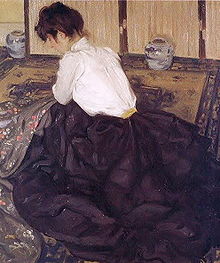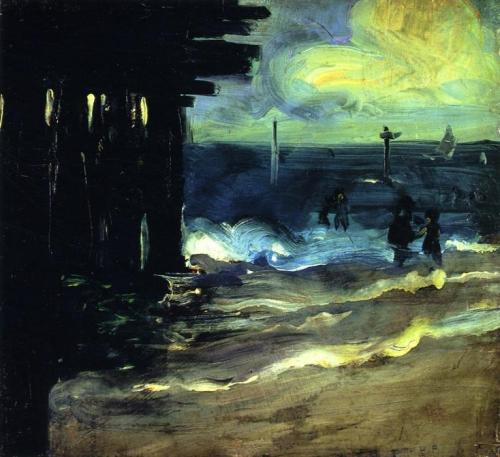This
spring, the Addison Gallery of American Art, located on the campus of Phillips
Academy in Andover, Massachusetts, will present Alfred Maurer: At the Vanguard
of Modernism, a comprehensive exhibition celebrating the American painter’s
singular accomplishments and invaluable contributions to American art in the
early twentieth century. After securing a place as one of the most accomplished
late nineteenth-century American figurative artists, Maurer (1868-1932) went on
to join the ranks of the avant-garde.
From
his cross-fertilization of Fauvism between French and American circles to his exploration
of abstraction in his late radical works, Maurer proved to be a formidable
creative force in expanding the potential for artistic expression in American art.
Alfred Maurer opens will be on view through July 31.
Following
its run at the Addison, the exhibition will travel to Crystal Bridges Museum of
American Art in Bentonville, Arkansas,where it will be on view October 10, 2015–January
4, 2016.
“All
phases of Maurer’s artistic career are covered in this groundbreaking exhibition,
which features his fin-de-siècle figure paintings, scenes of contemporary
leisure, Fauvist works, landscapes and florals, heads and figures, still lifes,
and late abstractions, including the Addison’s own Still Life with Pears,” Susan
Faxon, the Addison’s Associate Director and Curator of Art Before 1950, notes. “While
Maurer is often characterized as a painter of divergent, seemingly
contradictory aesthetics, this careful study of his oeuvre reveals steady
interest in thematic ideas as well as formal experimentation with color, form,
and abstraction.
”With
an intimate knowledge of the most current French art and friendships with key
vanguard American art figures, Maurer was positioned at the nexus of new ideas
about art. He left New York for Paris to study in 1897 and remained there until
the outbreak of World War I. While abroad, he became an intimate of Leo and
Gertrude Stein’s circle of creative luminaries. Through his involvement with
the Steins, Maurer became one of the first Americans to experience the work of Henri
Matisse, as well as Paul Cézanne, Paul Gauguin, and Pablo Picasso, among others.
He
in turn played a key role in introducing fellow Americans to their vanguard artistic
salon, which was brimming with progressive art and ideas. Maurer continued to bridge
French and American Modernism through the sophisticated Fauve work he was
producing and exhibiting in Paris as early as 1906.
Witness
to and participant in the development of revolutionary artistic ideas, he was
perfectly poised to elucidate others in their quest for knowledge of the latest
artistic developments. This included such important collectors as Dr. Albert C.
Barnes, for whom Maurer served as an agent while Barnes was building his remarkable
collection of twentieth-century masterpieces.
Maurer
proved to be an invaluable contact for other pioneering American figures of the
day as well, including Walt Kuhn, Walter Pach, and Arthur B. Davies, who, in
the early 1910s,assembled the pivotal exhibition commonly known as the Armory
Show.
Following
his return from Paris, Maurer moved in the most current art sets in New York,
sustaining close friendships with individuals who were committed to changing
the direction of American painting. In his quest to forge new paths, Maurer produced
some of the most advanced and adventurous workby an American in the first half
of the twentieth century.
“The
pioneering spirit of American Modernism is crystallized in Maurer’s late Cubist
paintings, a body of work rich with pictorial possibilities. This is avirtual
treasure trove of American art that turns a lens on theart of innovation and expression
in the modern age,”Dr. Stacey B. Epstein, the exhibition’s curator, adds.
Alfred Maurer: At the Vanguard of
Modernism
is accompanied by a fully illustrated exhibition catalogue that documents many
of Maurer’s most accomplished works and includes a comprehensive examination of
Maurer and his cultural context by Epstein, whose thorough and original
research sets Maurer in his rightful place within American Modernism. This
impressive catalogue is the first published since 1973 to focus solely on Maurer’s
work.
From the Wall Street Journal (images added):
... The first and largest room establishes Maurer as an accomplished Realist, incorporating elements of Manet, Whistler, Chase and John Singer Sargent.
Paintings here include the award-winning “
An Arrangement” (1901)
—a dark, moody portrait of a woman seated on a tilted floor—exciting for two Chinese vases, which feel whiplashed into being.
Typically, Maurer’s figures seem locked into place, as if he were nailing down all the details. In
“At the Shore” (1901),
calligraphically rendered children—secondary characters—are the most believable and satisfying.
Unusual here is Maurer’s assured, luminous gem
“Rockaway Beach with Pier” (c. 1901).
Its cursory forms—fluid surf, sand, boats, bathers and sky—suffused in blue light, magically coalesce...
In “Young Woman in Kimono” (c. 1901),
in which a brilliant blood-red overpowers a sea of earth tones, Maurer’s color seems to be attempting to break free, to take flight.
And in the loosely handled, standing life-size portrait “Jeanne” (c. 1904),
the woman, cigarette in hand, snidely glares at the viewer. Her tilted hat swoops like a bird. The next two galleries bustle with Fauvist landscapes, portraits and still lifes from 1907-14. Ecstatic, reborn, Maurer emulates Matisse, Maurice de Vlaminck and André Derain. Entering these galleries is like walking into a hothouse. In the best works here—including
“Fauve Landscape with Train” (c. 1907),
“Landscape with Trees” (1909),
“Autumn” (c. 1912)
and a series of “Fauve Landscapes” (c. 1908-12)—Maurer thinks, and breathes, in color....








